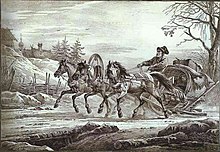| Revision as of 20:30, 27 May 2014 editKiwiNeko14 (talk | contribs)184 edits →Cultural icon← Previous edit | Revision as of 22:00, 27 May 2014 edit undoMontanabw (talk | contribs)Autopatrolled, Event coordinators, Extended confirmed users, Page movers, File movers, New page reviewers, Pending changes reviewers, Rollbackers105,545 editsm Reverted edits by KiwiNeko14 (talk) to last version by FrescoBotNext edit → | ||
| Line 19: | Line 19: | ||
| ], an example of ].]] | ], an example of ].]] | ||
| Troika has become a ], especially after it was featured in a scene of ]'s novel '']'',{{citation needed|date=March 2012}} where a "troika-bird" rides through the vast expanses of Russia ('']''). Gogol's "troika-bird" became a literary symbol of ] despite it was noted that the person carried by the troika, the protagonist of the novel, ], was actually a fraudster buying the "dead souls", i.e. the documents on ownership of the dead ] whose death was still not registered by population censuses, in order to put them ] and make money as well as a fake fame of rich serf owner. The paradox that the "troika-bird" of Russia carries the swindler Chichikov has been discussed in ]'s short story ''Started Skidding'' (''"Забуксовал"'').<ref></ref> | Troika has become a ], especially after it was featured in a scene of ]'s novel '']'',{{citation needed|date=March 2012}} where a "troika-bird" rides through the vast expanses of Russia ('']''). Gogol's "troika-bird" became a literary symbol of ] despite it was noted that the person carried by the troika, the protagonist of the novel, ], was actually a fraudster buying the "dead souls", i.e. the documents on ownership of the dead ] whose death was still not registered by population censuses, in order to put them ] and make money as well as a fake fame of rich serf owner. The paradox that the "troika-bird" of Russia carries the swindler Chichikov has been discussed in ]'s short story ''Started Skidding'' (''"Забуксовал"'').<ref></ref> | ||
| The intro of ''Вести'' ({{transl|ru|''Vesti''}}), the news programme that airs on ], features a troika since 1990<ref></ref>. | |||
| ==See also== | ==See also== | ||
Revision as of 22:00, 27 May 2014


A troika (Russian: тройка, "triplet" or "trio") is a traditional Russian harness driving combination, using three horses abreast, usually pulling a sleigh. It differs from most other three-horse combinations in that the horses are harnessed abreast. The middle horse is usually harnessed in a horse collar and shaft bow; the side horses are usually in breastcollar harness. The troika is traditionally driven so that the middle horse trots and the side horses canter; the right-hand horse will be on the right lead and the left-hand horse on the left lead. The troika is often claimed to be the world's only harness combination with different gaits of the horses.
The term "troika" is sometimes used to refer to any three-horse team harnessed abreast, regardless of harness style or what horse-drawn vehicle is used.
At full speed a troika can reach 45–50 kilometres per hour (28–31 mph), which was a very high speed on land for vehicles in the 17th–19th centuries, making the troika closely associated with the fast ride.
The troika was developed in Russia during the 17th century, first being used for speedy delivering of mail and then having become common by the late 18th century. It was used for travelling in stages where teams of tired horses could be exchanged for fresh animals to transport loads over long distances. Prior to this time, only groups of three or more people could use three horses, and a single person or two people had the right to only drive a single horse or a pair.
During the Russian Empire, the upper classes would use a troika driven by a livery-clad postilion. Decorated troikas were popular in major religious celebrations and weddings.
The troika was a part of both urban and rural culture. The horses usually driven in a troika were generally plain and rather small; for example the Vyatka horse was not taller than 14.1 hands (57 inches, 145 cm). However, the wealthy preferred to use the elegant Orlov Trotter.
The first troika competitions were held in the Moscow hippodrome in 1840. The troika was also exhibited at the 1911 Festival of Empire in London.
Cultural icon

Troika has become a cultural icon of Russia, especially after it was featured in a scene of Nikolay Gogol's novel Dead Souls, where a "troika-bird" rides through the vast expanses of Russia (Oh troika, winged troika, tell me who invented you?). Gogol's "troika-bird" became a literary symbol of Russia despite it was noted that the person carried by the troika, the protagonist of the novel, Chichikov, was actually a fraudster buying the "dead souls", i.e. the documents on ownership of the dead serfs whose death was still not registered by population censuses, in order to put them into pledge and make money as well as a fake fame of rich serf owner. The paradox that the "troika-bird" of Russia carries the swindler Chichikov has been discussed in Vasily Shukshin's short story Started Skidding ("Забуксовал").
See also
- Combined driving
- Driving (horse)
- Horse harness
- Horse-drawn vehicle
- Trigarium
- Types of carriages
- Zhirinovsky's ass
References
- Russian troika at equiros.ru Template:Ru icon
- Again about troika at pravdin.su Template:Ru icon
- Василий Макарович Шукшин
- Russian troika at zooclub.ru Template:Ru icon
- Jingle bells at damascus.ru Template:Ru icon